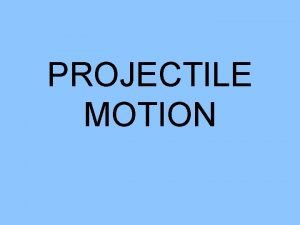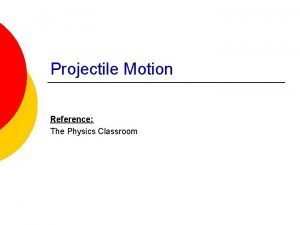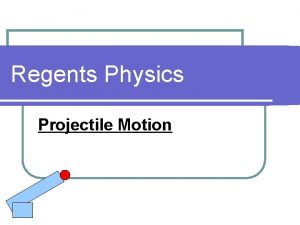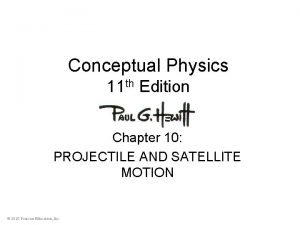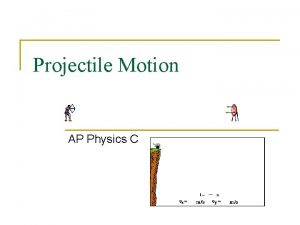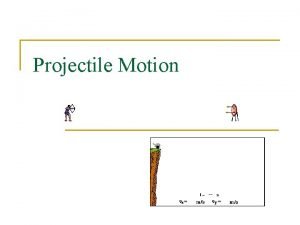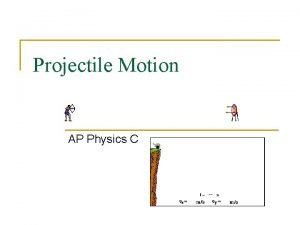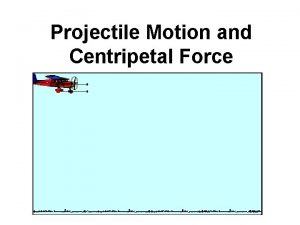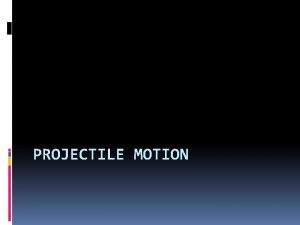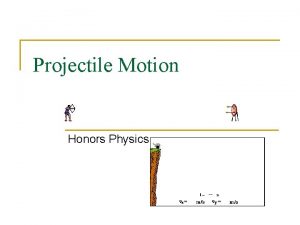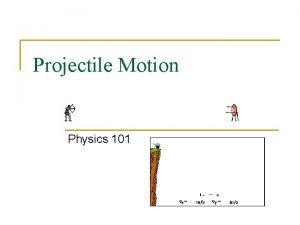Projectile Motion AP Physics C What is projectile











- Slides: 11

Projectile Motion AP Physics C

What is projectile? Projectile -Any object which projected by some means and continues to move due to its own inertia (mass). The only force acting on the object is gravity

Projectiles move in TWO dimensions Since a projectile n moves in 2 dimensions, it therefore has 2 components just like a resultant vector. Horizontal and Vertical

Horizontal “Velocity” Component n NEVER changes, covers equal displacements in equal time periods. This means the initial horizontal velocity equals the final horizontal velocity In other words, the horizontal velocity is CONSTANT. BUT WHY? Gravity DOES NOT work horizontally to increase or decrease the velocity.

Vertical “Velocity” Component n Changes (due to gravity), does NOT cover equal displacements in equal time periods. Both the MAGNITUDE and DIRECTION change. As the projectile moves up the MAGNITUDE DECREASES and its direction is UPWARD. As it moves down the MAGNITUDE INCREASES and the direction is DOWNWARD.

Combining the Components Together, these components produce what is called a trajectory or path. This path is parabolic in nature. Component Magnitude Direction Horizontal Constant Vertical Changes

Horizontally Launched Projectiles which have NO upward trajectory and NO initial VERTICAL velocity.

Horizontally Launched Projectiles Example: A plane traveling with a horizontal velocity of 100 m/s is 500 m above the ground. At some point the pilot decides to drop some supplies to designated target below. (a) How long is the drop in the air? (b) How far away from point where it was launched will it land? What do I know? What I want to know? vox=100 m/s t=? x=? y = 500 m voy= 0 m/s g = -9. 8 m/s/s 1010 m 10. 1 seconds

Vertically Launched Projectiles NO Vertical Velocity at the top of the trajectory. Vertical Velocity decreases on the way upward Vertical Velocity increases on the way down, Horizontal Velocity is constant Component Magnitude Direction Horizontal Vertical Constant Changes Constant Decreases up, 0 @ top, Increases down

Vertically Launched Projectiles Since the projectile was launched at a angle, the velocity MUST be broken into components!!! vo q vox voy

Vertically Launched Projectiles You will still use kinematic #2, but YOU MUST use COMPONENTS in the equation. vo q vox voy
 Physics
Physics Tennis projectile motion
Tennis projectile motion Physics classroom
Physics classroom Projectile motion regents questions
Projectile motion regents questions Vyi physics
Vyi physics Vyf in projectile motion
Vyf in projectile motion What are two components of projectile motion
What are two components of projectile motion Tossed ball conceptual physics answers
Tossed ball conceptual physics answers Projectile motion ap physics
Projectile motion ap physics Final horizontal velocity
Final horizontal velocity What is projectile
What is projectile Physics javelin projectile motion
Physics javelin projectile motion

